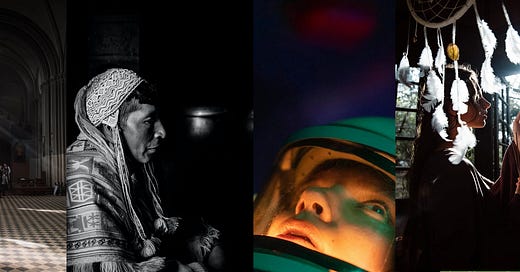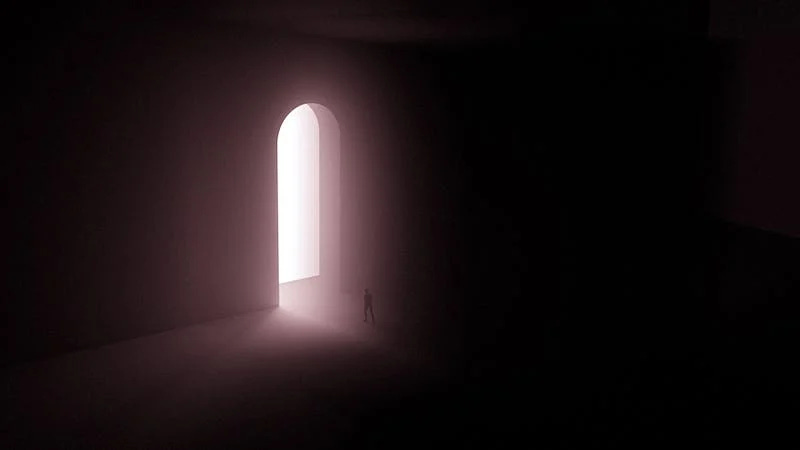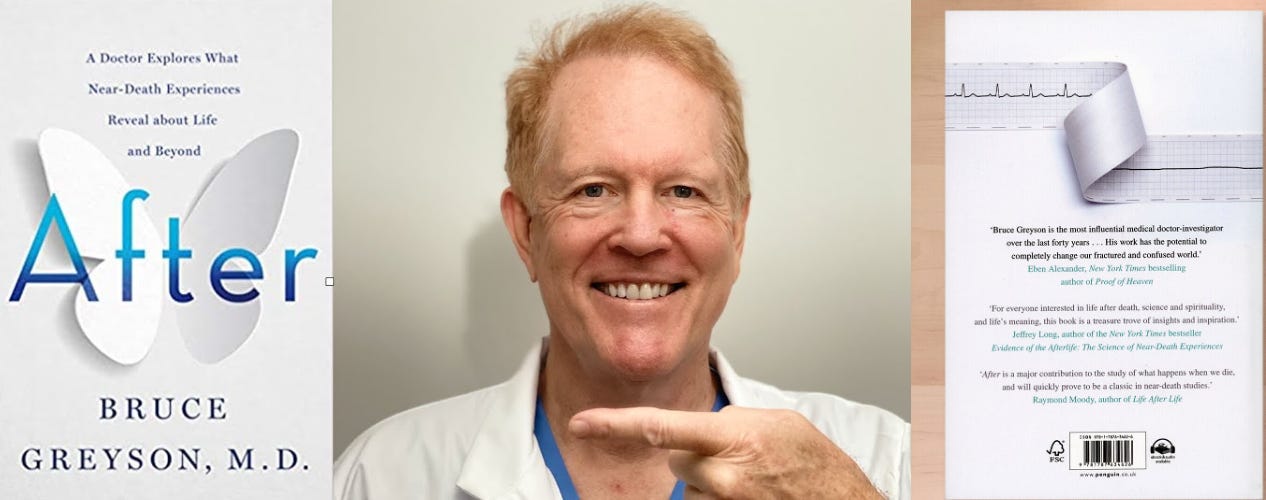🍄 The Light Persists
The questions of belief versus evidence may be the path to the understanding of consciousness.
Exploring every rabbit hole there is. For more wanderings, become an Alice in Futureland subscriber—it's free.
🍄 AudioDose Alice on Sonic Mushrooms: listen to Freewill
🎧 Alice podcasts
📘 Alice books: Tuning into Frequency: The invisible force that heals us and the planet
NDE (Near Death Experience) and OBE (out-of-body experience) have been popularly recognized in Western culture since the mid-1970s, but people from industrialized cities to ancient indigenous societies, from medical doctors to energy healers, from spiritualists to atheists, from neuroscientists to shamans have been witnessing them throughout history. The Light Persists!
The term NDE was coined by the US psychologist and philosopher Raymond Moody in his 1976 bestselling book Life After Life in which he presented the accounts of 150 people who’d come close to death, noting that they often contained the same features, such as: a bright light; an out-of-body experience; the comforting presence of other people; feelings of wellbeing and reduced fear.
Hello, we’re Alice and we are always in a state of wander. According to the University of Virginia School of Medicine’s Division of Perceptual Studies, Near-Death Experiences are intensely vivid and often life-transforming experiences, many of which occur under extreme physiological conditions such as trauma, ceasing of brain activity, deep general anesthesia or cardiac arrest in which no awareness or sensory experiences should be possible according to the prevailing views in neuroscience.
Dr. Bruce Greyson is the Chester Carlson Professor Emeritus of Psychiatry and Neurobehavioral Sciences at the University of Virginia who studies near-death experiences scientifically. His research has led to more than a hundred publications in medical journals. Through his research, he has discovered common and universal themes in near-death experiences that go beyond neurophysiological or cultural interpretations, as well as patterns of consistent aftereffects on individuals’ attitudes, beliefs, values, and personalities.
"The most common effect I have seen with people who have had NDEs is a conviction that death is not the end, but rather a transition, and that what comes after death, no matter how that is described, is not something to fear. And experiencers find that when they lose their fear of death, they also lose their fear of living to the fullest. As a result, their lives become more meaningful and fulfilling."
—Dr. Bruce Greyson
Many of the key features of an NDE are recounted not only by people who have nearly died, but also by people who have taken psychedelic drugs. Such drugs are known as the ‘classic psychedelics’, and include LSD (lysergic acid diethylamide), psilocybin (the hallucinogenic compound in magic mushrooms) and DMT (dimethyltryptamine or ‘spirit molecule’, which is found in several plants located in the Amazon basin).
The research around NDEs and OBEs (out-of-body experiences) are a growing inquiry that challenges many scientific assumptions around the material world and our understanding of consciousness beyond the physical brain. Traditionally, metaphysical experiences have been rendered inherently ‘unscientific’ over time. However, today, the questions of belief versus evidence may be the path to the understanding of consciousness.
In 2002, ALICE sat down with an international authority on near-death states, Dr. PMH Atwater, L.H.D. Atwater uses the culmination of her research to establish that the near-death phenomenon is not some kind of anomaly, but is rather part of the larger genre of transformations of consciousness.
The following excerpt is from ALICE 2002 interview with Dr. PMH Atwater:
“I’m a researcher of near-death states and spiritual transformations. I’ve been doing this for decades. I began my work with spiritual transformations in the ‘60s and ‘70s, researching altered states of consciousness, psychic phenomena, mysticism. And counterpoint to that, I was very active in the business world, very active in Idaho state government. Very logical, very objective, and an individual who had to find out why, had to know why behind everything. And then all of that was taken away from me. I mean, that’s it, I died. I mean, I died. I physically died in 1977 three times in three months. In my third near-death experience I reached that point we call in research ‘the realm of all knowing'.”
“Many near-death experiencers reach that realm, or dimension, or that place, or whatever you want to call it—where suddenly you know all things or at least the puzzle pieces to your life are explained, you understand why the child died, you understand why there was a war, why Uncle Charlie lost an arm, and so forth. So, you know, this is the realm of all knowing.”
“I began my research in November of 1978. I used police investigative techniques as my protocol. I remember my Dad who was a policeman saying in my head, ‘If your research doesn’t stand up in a court of law, throw it out the door.’ You know, you can’t ask normal kinds of questions.”
“The bulk of my research was all—magical. It was just magical! I would be in the elevator, and the people in the elevator would be near-death experiencers. I’d hire a cab, and the cabbie would be a near-death experiencer.”
“Just to give you an example, of how incredible this was, I rented a cab in Minneapolis. A fellow was driving. I’m a very curious person, and when I’m in a given area I want to know all about your industry, your academia. I want to know all about your financial base, what the people do for entertainment. I want a good clear picture of the strata of life in that area. So I was asking the cabbie all these questions—and it turns out that the guy was an exchange student from Egypt. So he just apologized and said, ‘Well, I’m sorry, I don’t know any of this. But I can tell you about that time I died.' And, and I said, 'You died?' He said, 'Yeah, yeah, and there was life on the other side of death.’”
“One time I got into a cab in Washington DC, I was in a big rush and I didn’t even have a second to say a word to the cab driver. He just kept looking at me and looking at me. And finally he said, 'I know' and he stuck out his finger at me, 'I know you’ve died. That means I can tell you about my death.' And then he started telling me about his near-death experience. I hadn’t even said hello to the guy.”
“Today I have the largest known research base: 3000-plus adult experiences, 277 child experiences. I say 3000-plus because I stopped counting at 3000, it was a nice, round number.”
Near-death experiences are transformations of consciousness
“After 24 years of researching near-death states, I can honestly say that the near-death experience is not any kind of anomaly. It’s not. It’s part of the larger genre of transformations of consciousness. I say this because, any type of transformations of consciousness that you can name has the same or similar after-effects as a near-death experience. That tells me we’re talking about one thing. These experiences change the body and the mind as well as the emotions. I mean, we’re talking about an experience that has both physiological and psychological after-effects.”
“I’m convinced after all this work, that there is a system within us, that we are structured in such a way to have these kinds of experiences, or shift and evolve in spiritually significant ways. For instance, we have the system in our body, I think we can all recognize, called procreation or birth. We have the sex organs, you know these different parts of our body—the system is in place that allows us to procreate. I’m suggesting, I’m saying, I’m implying—and rather loudly, yes, I sure am—that we also have within us a system to recreate ourselves, to renew ourselves, to transform ourselves.”
“That it is a physical system with mechanisms within us, physical, structural mechanisms within us, that when triggered will begin the process of transforming our consciousness. Once the consciousness begins to transform, then you see. You begin to see brain structure changes, chemical and functional changes in the brain, you begin to see changes in the nervous system, you begin to see changes in the digestive system, you begin to see changes in the faculties. What you begin to see is an expansion.”
Brain-shift, spirit-shift
“I really am convinced that we have this system, this mechanism within us that when triggered—and I don’t care what does the triggering—that when triggered will start off and then begin to advance the process. What do I mean by ‘process’? Well, I call it a ‘brain-shift, spirit-shift.’ We know now through research, neurological research—PET scans, brain scans, all kinds of research—that a sudden, exotic, and unexpected thought that catches your attention and really grabs you can change your brain structure in as little as 15 minutes. If that can happen, and it does, then imagine what a near-death experience can do to you. I’m excited about the fact that there’s a mechanism—and we’re talking about transformations of consciousness—here is a mechanism that seems to advance the human family. That seems to advance us as a species. That helps us to expand, accelerate, and heighten our faculties, and sense mechanisms, and digestive mechanisms, and nervous system, and brain structure, to a higher level. Always moving up. Always expanding out more. Always becoming more of ourselves.”
“Going back through history, we’ve got a lot of oral history that talks about our avatars, our wise ones, our great teachers in a culture. And they do indeed seem to fit the pattern of someone who has had one of these kinds of experiences, they certainly went through after-effects and became this great teacher, or avatar afterward.”
“I want you to get a sense here that we’re talking about something very dynamic. We’re not just talking about a change in attitude, or losing the fear of death and becoming more generous and loving. We’re talking about a very complex dynamic that is difficult to define. You cannot easily define these experiences. So I’m not just talking about near-death experiences, I’m talking about the larger genre of changes of consciousness. Once that trigger occurs, you can almost go step by step through what is visible, overt and knowable. You can see it in how it changes the individual.”
“When we look at transformations of consciousness, I don’t care where in the world you are, we’re looking at people who become more spiritual, less religious. That’s not true in all cases, but it’s true in most cases. When I say ‘spiritual' I’m talking about people who now realize that being inclusive is the only reality—you can’t be exclusive. You can’t be fixed in your thinking anymore, there’s no one gender that’s better than another. There’s no one country that’s better than another. These experiences wake us up. They’re awakenings. They help us to realize that whatever we say to someone else, we also say to ourselves, and what we do to someone else we, at least in part, do to ourselves. And that there is an accounting and that there is a responsibility here, and that accounting seems to be on another level, in another dimension, but it’s still there. It still happens. It has everything to do with you.”
There are, from my research, 3 distinctive kinds of light that are experienced by people who undergo a transformation of consciousness.
“And I can be more specific here with near-death experiencers, but it certainly affects the larger group, all of us, to one extent or another. And when I’m talking about the primary light, it doesn’t have any particular color. It’s more of a pulsating radiance. And it’s very raw. It’s very piercing. It’s extremely powerful. Just this raw, piercing, pulsating, colorless light. And then we have the dark light or black light experience. Many experiencers say that black light has tinges of purple in it. I’m talking about a light that is warm and safe and rich and healing and wonderful and intelligent. The children call it 'the darkness that knows.' As if it wasn’t a light at all, but rather an intelligence—a field of intelligence. And then we have the bright light, or white light, or yellow light, or golden light, in that range. And there’s something very creative and spontaneously enthusiastic about this light. Unconditional love. Forgiveness. But it seems to enhance our faculties to incredible degrees.”
“When we’re talking about the faculty changes that occur—and I don’t use the word ‘psychic.’ I often don’t even use the word ‘intuitive.’ Because when you’re looking at psychic things, when you’re looking at intuitive things, all that is is expansions and accelerations of faculties that are normal to us. That’s all it is. If you look back in time, part of our survival kit as our ancestors…obviously we were more psychic and intuitive then. We had to be, to survive. And with the industrial revolution and becoming more cultured and becoming more trained in the sciences, we’re leaving behind more and more of these abilities that we had way back when, when we were more in concert with the natural world.”
“Among these abilities that we had back then that many neurologists talk about now is synesthesia. Synesthesia is multiple sensing. Multiple sensing is, very simply, an elaboration, enhancement, or acceleration of the limbic system in the brain. The limbic system—it’s very very small, but it is the most complicated structure on Earth. One of the things I noticed as, in my research back in the ‘60s and ‘70s with experiencers of altered states of consciousness and various types of mysticism—and again, with near-death experiences—is how many of these experiencers have the ability to sense in multiples afterward, i.e. they have synesthesia.”
And on life today: It’s time now for all of us to heal.
“It’s time to know the truth and it’s time to heal. And the truth is, we all have a right to a reasonable life where we can be creative and we can learn and we can grow. It’s time to heal. It’s time to realize how powerful we are, how divine we are. It’s time to honor that. It’s time to recognize the sacredness of breath, the sacredness of laughter, of joy. It’s time to heal. I don’t care who you are, there are wounds somewhere. Even our so-called leaders. Even our spiritual leaders, the high holy ones. We’re all children equal in the sacred light. We’re here to heal. That’s enough. Let’s enjoy it.”
Thank you, PMH Atwater.
What else we are wandering…
📘 A Manual for Developing Humans by P.M.H. Atwater based entirely on threes, there are no chapters, only the development of conscious, subconscious, and superconscious aspects to each topic. The Manual contains the basics on every level of life―from how to use your mind, develop and use intuition, understand color, sex, relationships, children, how to take out-of-body trips, interact with spirit beings, meditate, bend time, and rethink money.
📘 Dr. Greyson is the author of After: A Doctor Explores What Near-Death Experiences Reveal About Life and Beyond. The book challenges our everyday ideas about our minds and our brains and offers key insights on how we can begin to live a more meaningful and fulfilling life.
🌎 On the 40th anniversary of the famous ‘Blue Marble’ photograph taken of Earth from space, Planetary Collective presents a short film documenting astronauts’ life-changing stories of seeing the Earth from the outside – a perspective-altering experience often described as the Overview Effect. The Overview Effect, first described by author Frank White in 1987, is an experience that transforms astronauts’ perspective of the planet and mankind’s place upon it. Common features of the experience are a feeling of awe for the planet, a profound understanding of the interconnection of all life, and a renewed sense of responsibility for taking care of the environment. ‘Overview’ is a short film that explores this phenomenon through interviews with five astronauts who have experienced the Overview Effect. The film also features insights from commentators and thinkers on the wider implications and importance of this understanding for society, and our relationship to the environment.
“To be Jedi is to face the truth, and choose. Give off light, or darkness. Be a candle, or the night.”—Yoda
Craving more?
📘 Alice in Futureland books
🎧 Alice in Futureland podcasts
Thanks for tuning in.
For more wanderings, become an Alice in Futureland subscriber—it's free.
Invite your friends to this mad tea party and let's see how many things we can learn before breakfast.
©2024 Alice in Futureland











